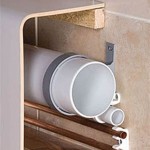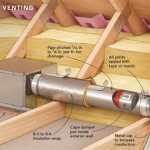Navigating the Bathroom Sink P Trap: Adapting from 1 1/4 to 2 Inches
The plumbing beneath a bathroom sink, though often overlooked, plays a critical role in maintaining a functional and sanitary environment. The P trap, a curved section of drainpipe, is particularly important, preventing sewer gases from entering the bathroom and allowing debris to settle, reducing the likelihood of downstream clogs. While standard bathroom sink drain sizes are typically 1 1/4 inches, situations often arise where a conversion to a 2-inch pipe is necessary or desirable. This article will explore the reasons for such a conversion, the components involved, the installation process, and potential considerations that arise during the adaptation of a bathroom sink P trap from 1 1/4 inches to 2 inches.
The need for adapting a P trap typically stems from one of several scenarios. Remodeling projects may involve replacing older fixtures with newer ones that require a different drain size. Furthermore, building codes in some localities may mandate a specific drain size for certain applications. Occasionally, individuals may choose to upgrade to a larger drain size in anticipation of handling a higher volume of wastewater or to minimize the risk of clogs in the long run. Whatever the reason, understanding the differences between the sizes and the appropriate methods for conversion is essential for a successful plumbing outcome.
Understanding the Purpose of the P Trap
The P trap is not merely a random bend in the drainpipe; it is a carefully designed component with a specific function. The primary purpose is to maintain a water seal within the curved portion of the pipe. This water seal acts as a barrier, preventing sewer gases, which are often odorous and potentially hazardous, from rising up through the drain and into the living space. Without a functional P trap, these gases could freely enter the bathroom, creating an unpleasant and potentially unhealthy environment.
In addition to preventing gas intrusion, the P trap also serves as a rudimentary settling basin. Heavier debris, such as hair, soap scum, and small objects that may accidentally fall into the sink, tend to settle at the bottom of the P trap. This prevents them from traveling further down the drainpipe and potentially contributing to more significant blockages downstream. While the P trap itself can become clogged over time, its design allows for relatively easy access for cleaning and maintenance, mitigating the impact of accumulated debris.
The standardized design of P traps allows for interchangeability and ease of repair. When a clog does occur, the P trap can often be disassembled, cleaned, and reassembled without the need for specialized tools or extensive plumbing knowledge. This simple but effective design makes the P trap a crucial component of any functional drain system.
Reasons for Converting from 1 1/4 to 2 Inches
The standard drain size for most bathroom sinks is 1 1/4 inches. This size is generally adequate for handling the typical flow of water and waste from a bathroom sink. However, there are several reasons why someone might choose to convert to a 2-inch drainpipe.
One of the most common reasons is to comply with local building codes. Some jurisdictions have specific requirements for drain sizes, particularly in new construction or during remodeling projects. These codes may mandate a 2-inch drain for all plumbing fixtures, including bathroom sinks, to ensure adequate drainage capacity and prevent potential sewer backups. Familiarizing oneself with local building codes is crucial prior to undertaking any plumbing modifications.
Another reason for conversion is to increase drainage capacity. While a 1 1/4-inch drain is sufficient for normal use, it may struggle to handle a large volume of water, such as when quickly emptying a full sink or when the sink is connected to a high-flow faucet. A 2-inch drain can accommodate a significantly larger volume of water, reducing the risk of overflow and improving overall drainage performance. This is especially important in households with multiple users or in situations where the sink is frequently used for tasks that require a large amount of water.
Finally, a larger drain size can also reduce the risk of clogs. The larger diameter of a 2-inch pipe allows larger debris particles to pass through more easily, minimizing the chance of a blockage forming. While it doesn't eliminate the possibility of clogs entirely, it can significantly reduce their frequency, particularly in households where hair, soap scum, or other debris are common in the drain.
The Conversion Process and Necessary Components
Converting a bathroom sink P trap from 1 1/4 inches to 2 inches involves a series of steps and requires the use of several specialized components. The specific components needed will depend on the existing plumbing configuration and the desired outcome, but the following are typically required.
First, a 1 1/4-inch to 2-inch adapter is essential. This adapter allows the existing 1 1/4-inch drain tailpiece (the pipe that connects directly to the sink drain) to connect to a 2-inch P trap. These adapters come in various materials, including PVC and ABS plastic. Ensuring that the adapter is compatible with the existing pipe material is crucial for a secure and leak-proof connection.
Second, a 2-inch P trap assembly is needed. The P trap itself typically consists of several sections of pipe that are connected using slip joints and compression fittings. The assembly should include a U-bend section, a tailpiece extension, and a wall connection. The material of the P trap should match that of the adapter and the existing drainpipe to prevent corrosion and ensure compatibility.
Third, additional lengths of 2-inch drainpipe may be required to connect the P trap to the existing drain line in the wall. The length of pipe needed will depend on the distance between the P trap and the wall connection. Again, it is important to use pipe that is compatible with the existing drain line.
Fourth, pipe cement or silicone sealant may be required to create watertight connections. Pipe cement is typically used for permanent connections, while silicone sealant is often used for slip joints that may need to be disassembled for cleaning or maintenance. Following the manufacturer's instructions for application is crucial for ensuring a leak-proof seal.
The conversion process begins with disconnecting the existing 1 1/4-inch P trap. This usually involves loosening the slip joint nuts and carefully removing the P trap assembly. Next, the 1 1/4-inch to 2-inch adapter is attached to the drain tailpiece. The 2-inch P trap assembly is then connected to the adapter and to the existing drain line in the wall. Ensuring that all connections are tight and leak-proof is critical. After the installation, running water through the sink to check for leaks is imperative. If any leaks are detected, the connections can be tightened or resealed as needed.
Potential Challenges and Considerations
While converting a bathroom sink P trap from 1 1/4 inches to 2 inches is a relatively straightforward process, several potential challenges and considerations should be taken into account. Planning and preparation are key to preventing problems and ensuring a successful outcome.
One potential challenge is dealing with existing plumbing configurations. In some cases, the existing drain line may be located in an awkward position, making it difficult to connect the new 2-inch P trap. This may require some creative problem-solving and the use of additional fittings or pipe extensions. It is often beneficial to carefully examine the existing plumbing before starting the project to identify any potential issues and plan accordingly.
Another consideration is the compatibility of materials. It is important to ensure that all of the components used in the conversion are compatible with one another. Mixing different materials, such as PVC and ABS plastic, can lead to leaks and corrosion over time. Always purchase components that are made from the same material and that are designed to work together.
Furthermore, proper ventilation is essential for a functional drain system. All drainpipes should be properly vented to allow air to enter the system, preventing a vacuum from forming and ensuring that water flows freely. If the existing drain line is not properly vented, it may be necessary to install a vent or to modify the existing venting system. This is a complex task that may require the expertise of a licensed plumber.
Finally, adhering to local building codes is paramount. Before undertaking any plumbing modifications, it is important to familiarize oneself with the local building codes and regulations. These codes may specify the type of materials that can be used, the size of drainpipes that are required, and the proper methods for venting drains. Failing to comply with these codes can result in fines and may require that the work be redone.
In conclusion, adapting a bathroom sink P trap from 1 1/4 inches to 2 inches can be a beneficial upgrade in certain situations. By understanding the purpose of the P trap, the reasons for conversion, the necessary components, and the potential challenges, homeowners and plumbers can ensure a successful and functional plumbing system.

Snappytrap Snappy Trap Universal Drain Kit For Bathroom Sinks Black Adapts To 1 4 In 2 Sink Drains And Wall Pipes The Under Plumbing Department At Com

Nibco 1 2 In X 4 Pvc Dwv Hub Slip Joint Trap Adapter C48017hd112114 The Home Depot

Have A Question About Oatey Heavy Duty 1 2 In To 4 Plastic Adjustable Diameter P Trap With Reducing Washer Pg The Home Depot
What Plumbing Piece Is Normally Used To Transition From 1 4 Bathroom Sink 2 Drain Pipe Quora

Snappytrap Universal Drain Kit For Bathroom Sinks Dk 105 The Home Depot

Keeney 400pvck 1 2 In Or 4 X Heavy Duty Pvc P Trap With Reversible J Bend Com

Nibco 1 2 X 4 In Pvc Dwv Trap Adapter Fitting C480127hd112114 The Home Depot

Nibco Part 4893112 1 2 In Or X 4 Pvc Dwv Hub Slip Joint P Trap Traps Home Depot Pro

Keeney 1 4 In Plastic P Trap The Under Sink Plumbing Department At Com

Traditional 17 Gauge Brass Sink Drain 1 4 P Trap Rejuvenation
Related Posts







